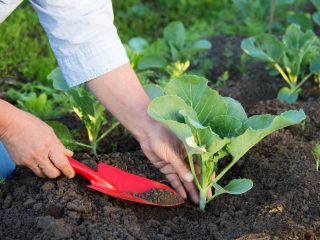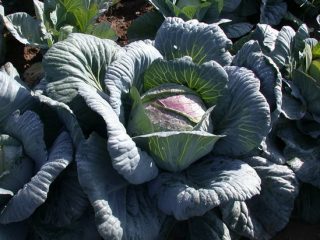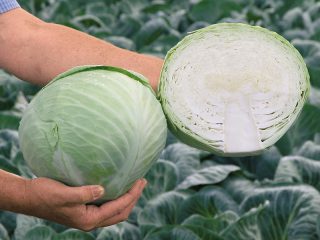Content
Many gardeners prefer to grow kohlrabi. After all, this variety of cabbage is a storehouse of vitamins and minerals. But the question often arises of how to properly store kohlrabi in winter so that the vegetable does not lose its commercial quality for as long as possible. Because gardeners complain that this type of cabbage spoils quickly. Therefore, it is worth figuring out how to prepare and store the harvest, and what to do if it is not possible to create optimal conditions for fresh vegetables.

When properly stored, kohlrabi pulp preserves useful components and its structure.
Which varieties are suitable for storage?
All varieties of this cabbage are divided into three types according to ripening time: early, middle and late. Only the last two are suitable for long-term storage in winter. They are characterized by a denser pulp structure and good keeping quality.
The types of kohlrabi also differ in the shade of the stem fruits. They come in light green and purple colors. The latter are more suitable for winter storage. They are able to retain commercial properties for 4-6 months under certain conditions.
The best varieties and hybrids for long-term conservation:
- Azur. It is distinguished by spherical stem fruits of a purple hue. Azur's pulp has a pleasant sweetish taste, moderately juicy, and dense. The variety easily tolerates drought, and its stem fruits do not crack. Belongs to the category of medium ripening.
The Azur harvest is stored for five months
- Violet. Forms a round thickened stem fruit of a rich purple hue, weighing up to 1 kg. Harvesting can be done 100 days after seed germination. The pulp is crispy and has a sweetish taste. The variety is suitable for fresh consumption, freezing, and processing.
Violetta can be sown already in the second half of April under cover
- Hummingbird F1. Hybrid with a rich purple hue of fruits. Their average weight is 300-400 g. The pulp is juicy, delicate taste, homogeneous, without fibers. The growing season is 70-80 days from the moment of emergence.
Hummingbird F1 is highly resistant to disease
- Alka. Characterized by inky purple stem fruits. Their weight reaches 0.6-0.8 kg. The shape of the fruit can be round or elongated. Universal use, high taste.
Alka is well preserved until the end of winter
Preparation for storage
In order for the crop to be stored for as long as possible, it must be harvested within a clearly defined time frame. Harvesting is recommended when the diameter of the stem fruit reaches 8-10 cm. It is important not to miss this moment, otherwise the pulp becomes lignified, which negatively affects the consumer qualities of the fruit.
You should choose a sunny day for harvesting. The procedure must be carried out in the morning at a temperature not lower than +3-5 °C.The harvested crop should be placed in the shade, where it should be sorted and wiped with a dry rag to remove any remaining soil. To store fresh kohlrabi for a long time, the root must be left and the shoots cut off at a height of 2-3 cm from the stem.
Storage conditions
To preserve the kohlrabi harvest for a long time, certain conditions must be observed. Inconsistency in the microclimate can lead to premature withering and spoilage of fruits, even in varieties that have good shelf life.
Primary requirements:
- temperature 0-+6 °C;
- humidity within 85-95%;
- lack of direct sunlight;
- good ventilation system.
How to store kohlrabi cabbage at home
To store kohlrabi cabbage at home, you can use a refrigerator, freezer, balcony, as well as a basement or cellar. If it is not possible to preserve it fresh, it is recommended to marinate and pickle the crop. To ensure that the product does not lose its beneficial properties for human health, you should know how long storage is possible in each specific case.

At room temperature, kohlrabi loses its consumer properties after 3-4 days
In a refrigerator
In this case, it is permissible to store the crop for 5-6 weeks. Before putting it in the refrigerator, you need to wrap each stem fruit with damp paper or cloth, and then fold it into a plastic bag and do not tie it. This will prevent the vegetables from rotting.

Kohlrabi can be stored in the bottom drawer of the refrigerator intended for vegetables.
In the freezer
Kohlrabi can be stored in the freezer for up to nine months.But at the same time, the product partially loses its taste.
Before storing stem fruits, they must be peeled, washed and dried. After this, cut them into small pieces and place them in boiling water in a colander for 2-3 minutes. And then immediately into ice water. Blot the chopped vegetables with a paper towel, place in food containers or plastic bags and place in the freezer.
On the balcony
You can also store kohlrabi cabbage for future use on a glassed-in balcony. It is important that in winter the temperature does not drop below 0 °C. However, storage of the vegetable in this case is possible for no more than 4-6 weeks. And then the kohlrabi stems wither, lose their elasticity and taste.
For storage on the balcony, you can hang the crop by the root on a rope. In this case, the distance between adjacent stem fruits should be 3-5 cm so that they are well ventilated and do not rot.
It is possible to store kohlrabi on the balcony and in wooden boxes. But before laying them in, it is necessary to wrap the stem fruits in paper so that they do not touch each other.
In the cellar or basement
This is the best way to preserve kohlrabi cabbage for the winter when harvesting a large crop of vegetables. In the cellar or basement, the microclimate corresponds to long-term conservation. It is recommended to place kohlrabi stem fruits in wooden boxes for storage, sprinkling them with wet sand. It is recommended to subsequently cover the container itself with film to prevent fading.
It is also possible to place stem crops in nets and then hang them from the ceiling at a distance of 3-5 cm from each other.At the same time, it is important that there is good air circulation in the basement or cellar so that the harvested crop does not rot.
Marinating and pickling
Canning kohlrabi is one of the most affordable ways to store it for the winter if you don’t have a basement or cellar. Pickling and salting are suitable for this. In both cases, the vegetable retains its pleasant taste and most of the beneficial components.
When marinating, you first need to start by preparing the filling. To do this, you will need to take 1 liter of water into an enamel container and add 100 g of salt, 50 g of sugar, 100 ml of vinegar. Boil the mixture and cool. After this, the kohlrabi needs to be peeled, cut into strips 0.7 cm wide and boiled for 15-20 minutes. And then drain the liquid, dry the cabbage and place in sterilized jars. At the end, pour hot marinade and roll up.

Storing the product for the winter is recommended in the refrigerator
When pickling kohlrabi, you need to peel the vegetables and cut them into strips. After this, immerse them in boiling water for a minute, and then cool and dry. To prepare the brine, you need to boil water and add salt, sugar and vinegar to taste, and boil for two minutes. After this, place the kohlrabi in a wide plastic or enamel container in layers, sprinkling the vegetable with grated carrots, chopped garlic, and herbs. Vegetables should be poured with hot brine and pressed under the lid. Keep the mixture for several days at a temperature of +18-20 °C. After this, place the finished snack in sterilized jars and roll up.
Common mistakes
Sometimes mistakes can significantly shorten the shelf life of a crop. To avoid this, you need to familiarize yourself with them in advance.
Among them:
- harvesting after the first frost;
- sudden changes in temperature during storage;
- insufficient ventilation in the vegetable storage;
- re-freezing the product.
Recommendations
When storing kohlrabi at home, you need to follow certain recommendations. This will allow you to preserve vegetables for as long as possible without losing their commercial quality.
Basic recommendations:
- When storing the crop for a short time in the refrigerator, the leaves and measles need to be cut off completely to reduce the evaporation of moisture from the stem crops.
- If the air in the basement or cellar is too dry, then you need to place containers of water next to the kohlrabi to create optimal conditions.
- Kohlrabi should be stored separately from other vegetables in the basement.
- Periodically you need to sort through the stem fruits and remove rotten specimens.
Conclusion
Knowing how to properly store kohlrabi in winter, you can count on the harvested crop to last as long as possible. After all, this vegetable is rich in a complex of vitamins and minerals that are so necessary for the human body in winter. Moreover, he preserves them not only fresh, but also frozen, pickled and pickled.












